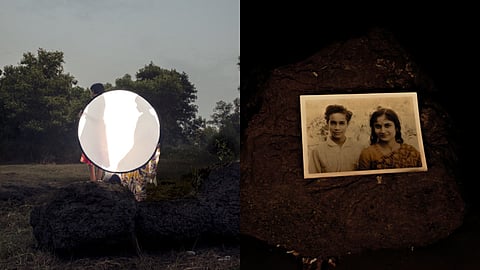
- HOMEGROWN WORLD
- #HGCREATORS
- #HGEXPLORE
- #HGVOICES
- #HGSHOP
- CAREERS
- ABOUT US
- CONTACT US

Last year, I remember writing on multi-award-winning Kolkata-born visual artist Soumya Sankar Bose’s intensely dark and provocative exhibition, A Discreet Exit Through The Darkness, which explores the disappearance of his mother during the autumn of 1969 during a tumultuous political era in her home state of West Bengal through a series of photographs and a film.
She was sent to the neighborhood sweet shop to buy sweets for a religious offering on the 24th of October. His mother, a little girl of nine, went prancing to the confectionery but did not return until three years later. The strangest part was the fact that due to prosopagnosia (face blindness), his mother was unable to recall any details of her life during those three years. It is almost as if she has no memory of that time period and she returned with a clean slate. She lives her childhood through two phases of her past — one that existed before her disappearance and the other that characterized her life after she was rescued. The intervening years are a massive void.
Soumya has built upon that photoseries to create his first international solo exhibition, Braiding Dusk and Dawn, at the Delfina Foundation in London. In this exhibition, you step into a darkened gallery, torch in hand, prepared to be enveloped by Soumya Sankar Bose's poignant exploration of loss and the fragmented nature of memory. This exhibition transcends the boundaries of traditional photography; plunging the viewer into a heart-wrenching family drama that resonates with the broader social and political turmoil of post-Partition Bengal.
As also seen last year in his Experimenter Colaba solo exhibition, here too Bose utilizes cutting-edge technology to showcase a 360° VR film. Here, the viewers don a VR headset and become one with Bose's grandfather, experiencing his relentless search for his missing daughter through fragmented memories of a dilapidated house filled with static-laced radio broadcasts of riots, which becomes a tangible manifestation of his anguish.
But Bose's pursuit of truth extends beyond a single perspective. The exhibition also includes the newly commissioned three-channel film, Things We Lost Last Night, where he crafts a disorienting account through the introspective voice of his now-aged mother. Her prosopagnosia becomes a metaphor for the elusiveness of the past. The narrative, informed by entries from her diary, weaves together fragments of political unrest, personal turmoil, and fantastical imagery — a one-eyed old lady, a Naxalite guerrilla, and a visit to a sinking holy town of Joshimath — these elements intertwine; mirroring the fractured landscape of her memories.
Bose doesn't shy away from historical context. Through meticulously researched snippets from archival newspapers, he infuses the personal with the political. The social unrest of the 60s and 70s in West Bengal becomes more than just a backdrop — it's a force that irrevocably shaped both his family and his city.
The accompanying photographs function as haunting soliloquies. Scattered throughout the darkened space, they invite a more intimate engagement with the characters' inner worlds. Using torches, viewers become detectives, piecing together fragments of a forgotten past. Soumyadoesn't offer easy answers. Instead, he invites the viewers to confront the complexities of memory and the enduring impact of historical trauma. Braiding Dusk and Dawn transcends the personal; becoming a powerful exploration of loss, resilience, and the enduring search for truth.
